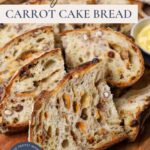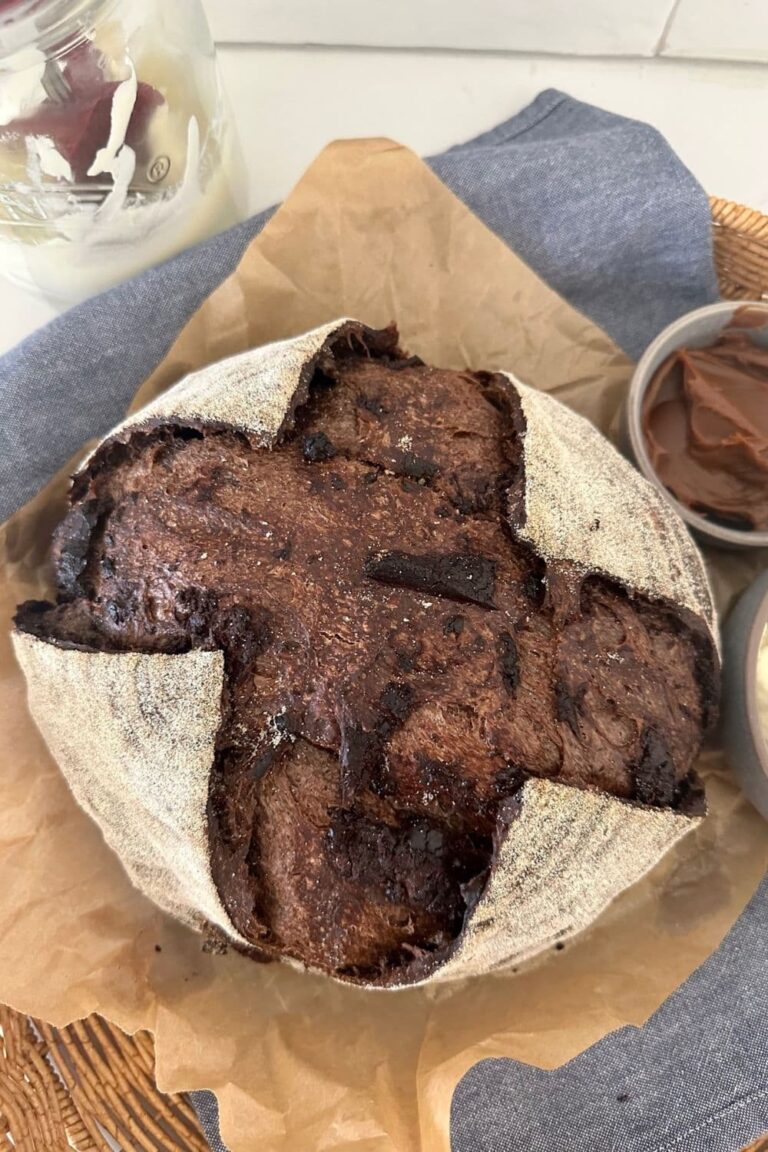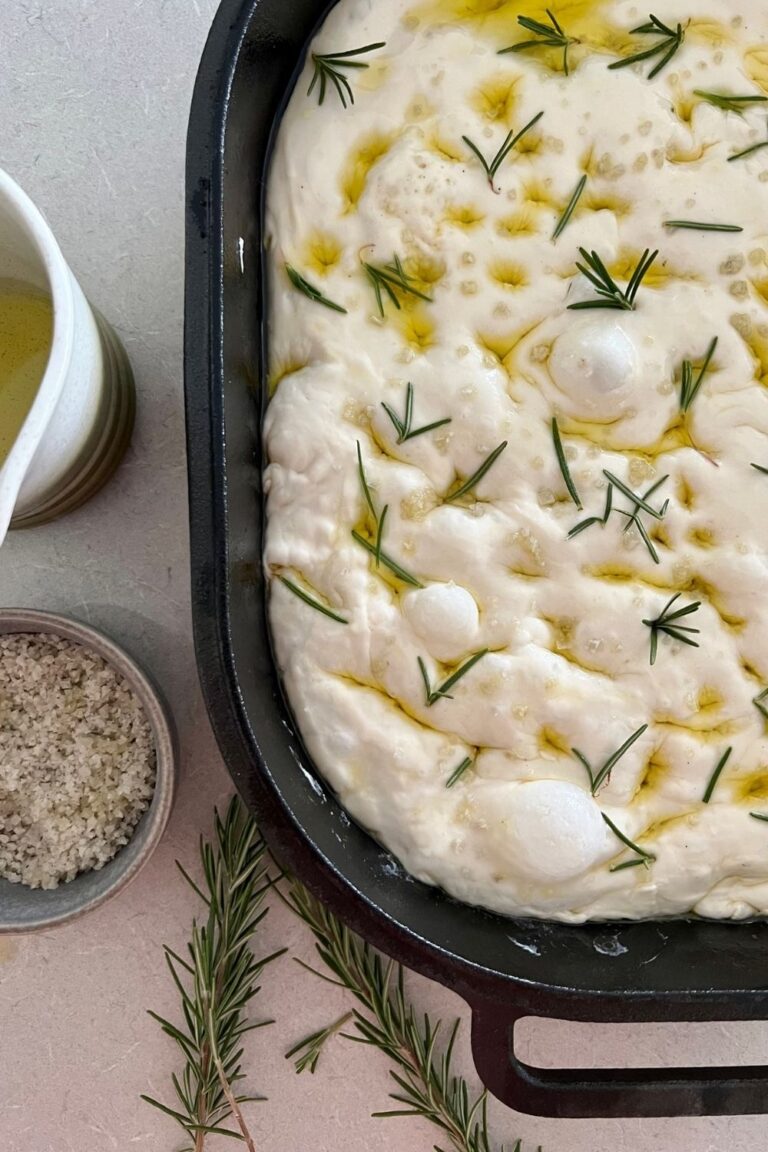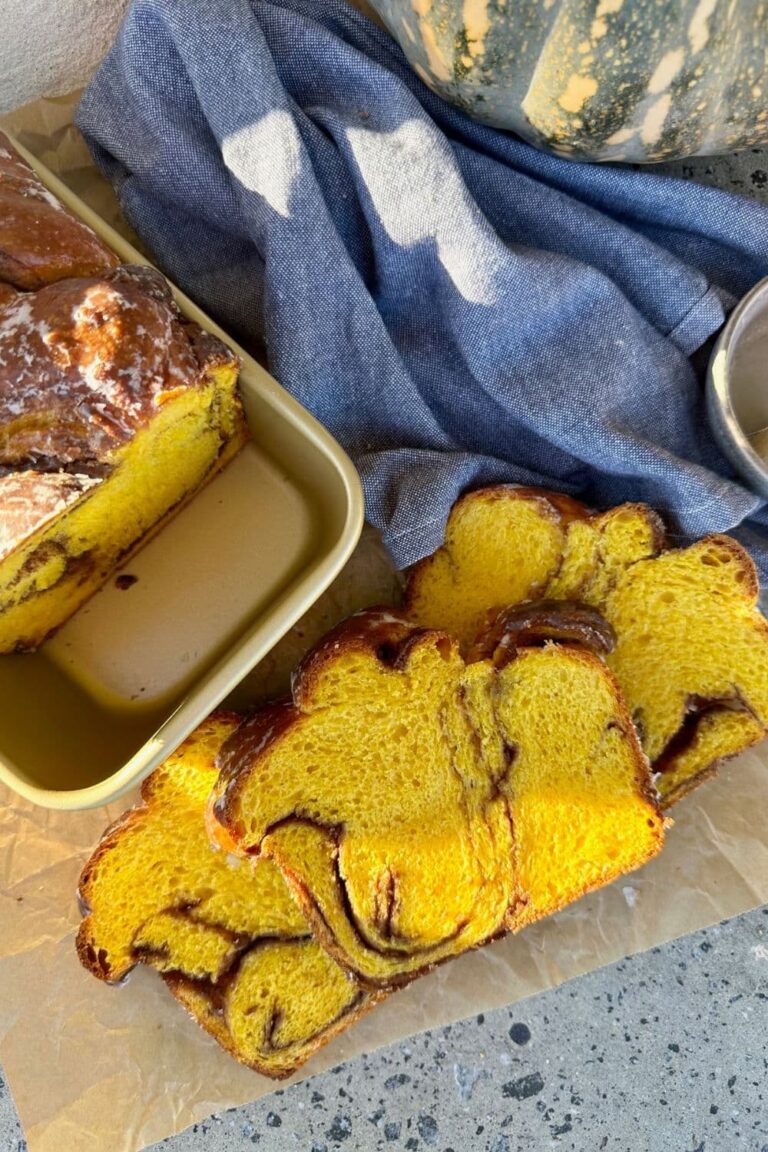Sourdough Carrot Cake Bread
This post may contain affiliate links.
If you're looking for a sourdough bread that's a little bit different, then sourdough carrot cake bread might be just what you're looking for. Studded with chopped pecans, juicy raisins and shredded carrot and swirled with cinnamon, nutmeg, ginger and brown sugar, this decadent sourdough loaf is sure to impress.
Reminiscent of your favorite carrot cake, this sourdough carrot cake bread is the perfect loaf to take centre stage for Easter or spring celebrations. And let's face it, we all love to share our sourdough inspiration at special holidays, right?
If you do love all things carrot cake and have some extra sourdough starter, then make sure you check out this sourdough carrot cake, sourdough carrot cake cookies and these sourdough carrot cake muffins.
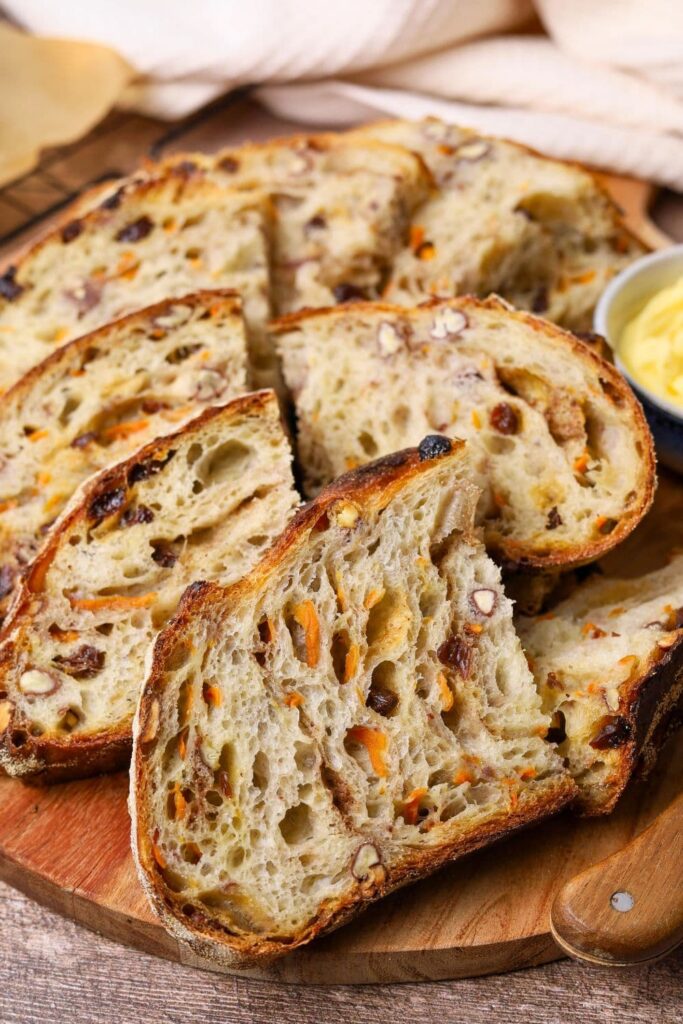
Why You'll Love This Recipe!
Something Different - think about your favorite carrot cake recipe and then put it inside your favorite loaf of sourdough bread and you'll get somewhere close to where this loaf of sourdough carrot cake bread lands. It's sweet, but not too sweet and absolutely perfect!
Perfect For Brunch - This gorgeous loaf of sourdough carrot cake bread is perfect for an Easter brunch with friends or to serve as a special Easter breakfast with family. It freezes really well too!
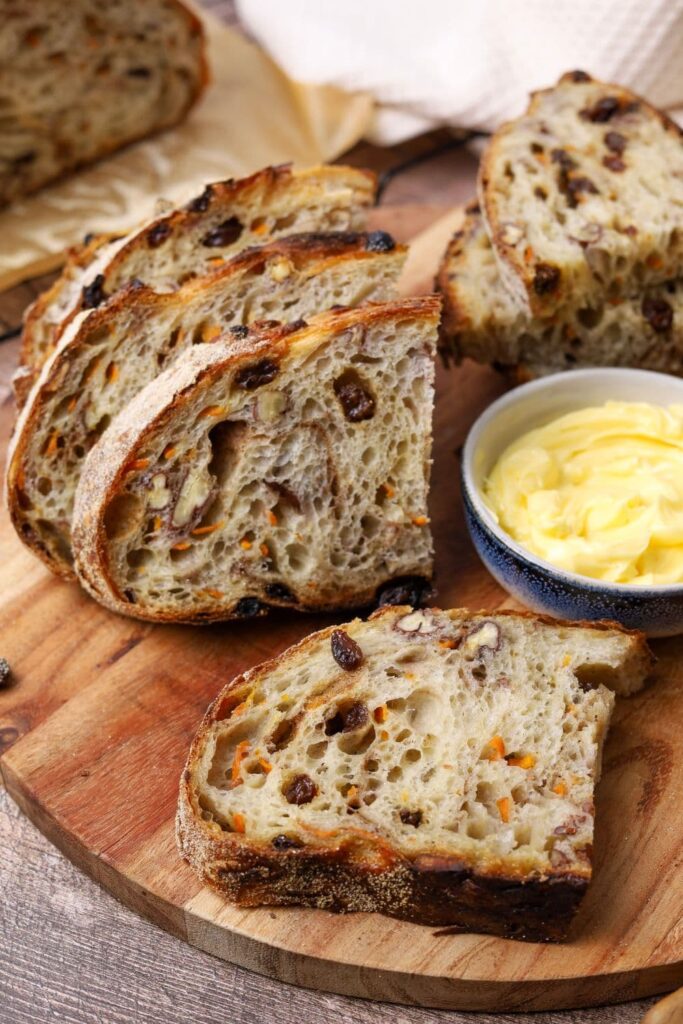
Ingredients
- Sourdough Starter - you'll need an active and bubbly starter that has been recently fed to create this sourdough carrot cake bread.
- Water
- Maple Syrup - I've used a little maple syrup to sweeten this loaf, but you can use honey if you prefer. It's a straight swap for weight if you do choose to use honey.
- Bread Flour - I recommend using bread flour for this recipe rather than all purpose flour. There are a lot of inclusions and you'll need as much protein as you can to create a strong gluten network to support the inclusions as your dough rises.
- Salt - you can adjust the salt to suit your own taste.
- Raisins - plump juicy raisins create a sweet surprise in this loaf.
- Pecans - roughly chop the pecans before adding them to ensure they distribute evenly through the dough. You can use walnuts as a substitute if you want to.
- Carrot - shred your carrot on a box grater. I've used a medium sized carrot, unpeeled. This is such a wonderful way to use fresh produce in your sourdough bread!
- Cinnamon, nutmeg and ginger - these fragrant spices create the same flavors as you'd find in your favorite carrot cake. I've added these during the shaping process rather than during the stretching and folding because they will affect fermentation.
- Brown Sugar - a little brown sugar is combined with the spices to create the sweet flavor swirls added at shaping in this loaf.
- All Purpose Flour - I've added just a little all purpose flour to the spice and brown sugar mixture to ensure that it doesn't leak out of the loaf during cold fermentation.
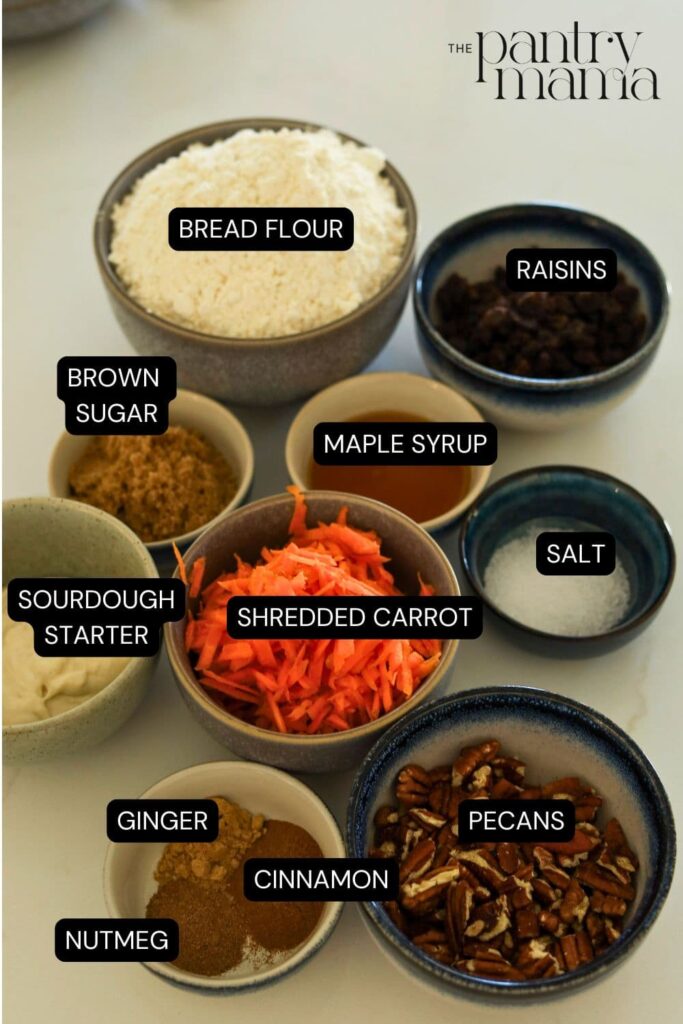
How To Make Sourdough Carrot Cake Bread
This sourdough carrot cake bread is a little different to put together than other sourdough loaves with inclusions because you'll add the maple syrup along with the water. Then you add some of the inclusions during the stretch and folds and then some of the inclusions at shaping.
The shredded carrot, raisins and pecans are added during the stretch and folds. The brown sugar and spices are added during the shaping process because they can affect fermentation, so it's best to add them after bulk fermentation is finished. This loaf is shaped in a similar way to this sourdough cinnamon swirl loaf.
Just follow along with each step and you can't really go wrong.
Pre Mix & Autolyse
Weigh out your starter, water and maple syrup in a glass or ceramic bowl. Mix them together so that the maple syrup is dissolved in the water (or at least really well distributed).Then add your bread flour and salt and mix altogether with a spatula. The dough will be fairly shaggy and only just brought together.
Cover your bowl with cling film or a damp tea towel and let it sit for around 1 hour.
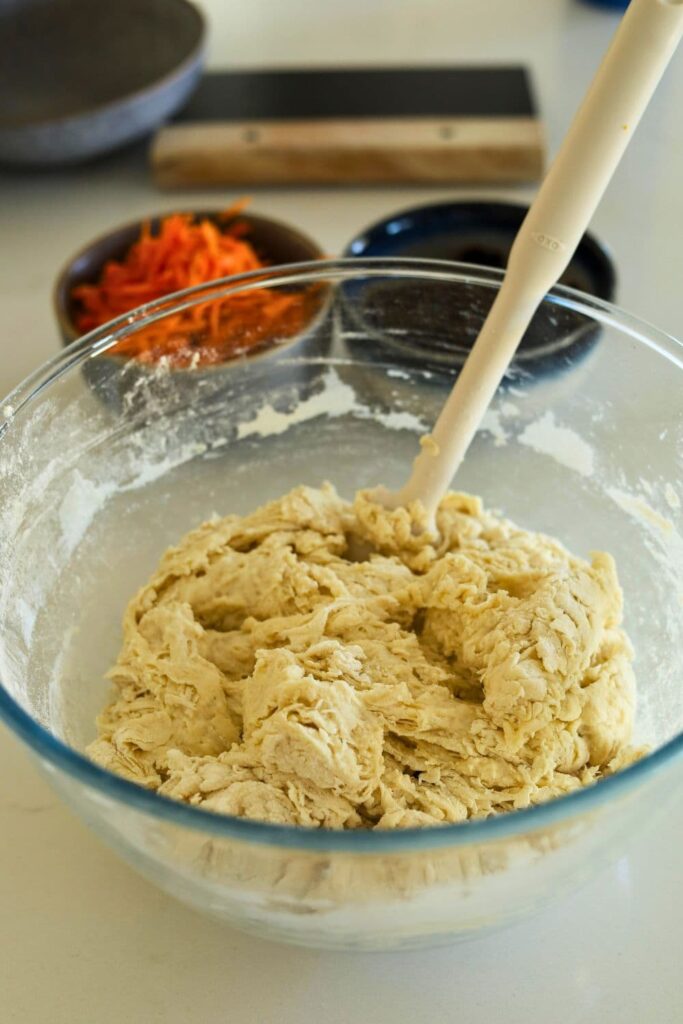
Forming Up Your Dough
Work your way around the bowl, grabbing the dough from the outside, stretching it up and over itself until a smooth ball is formed. You shouldn't need more than about 20-25 folds to form the ball. Once the dough has formed into a smooth ball, pop the cling film back on and let it rest for 30 minutes.
Stretch & Fold - Creating Structure
You need to add the raisins, chopped pecans and shredded carrot to your dough during the stretch and fold phase. It's very easy to do!
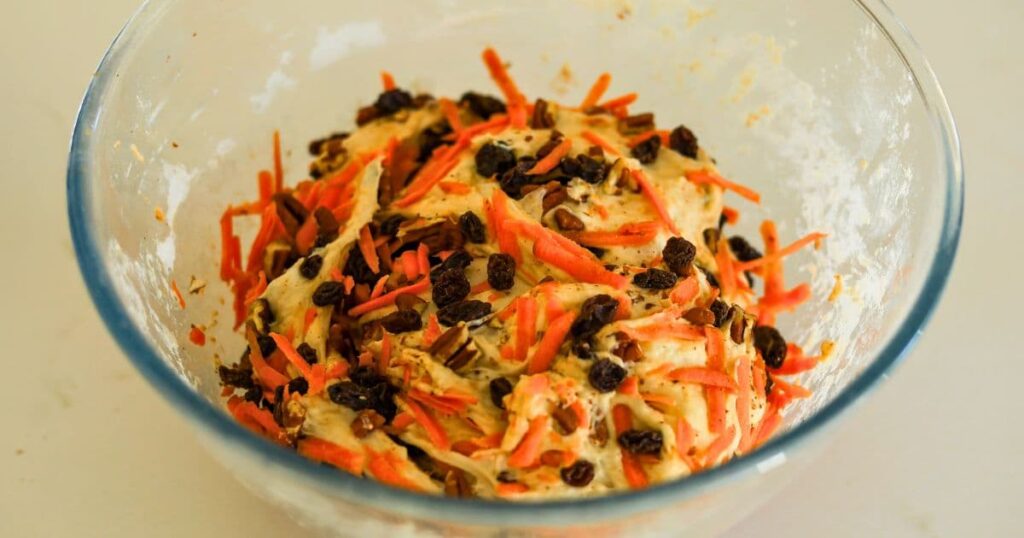
Try to add them around the second or third set of stretch and folds. So do your first set of stretch and folds with the dough as is and then add the inclusions on the second (or third) set depending on how your dough is behaving. Try to do around 4 sets of stretch and folds with around 15 to 30 minutes between each set.
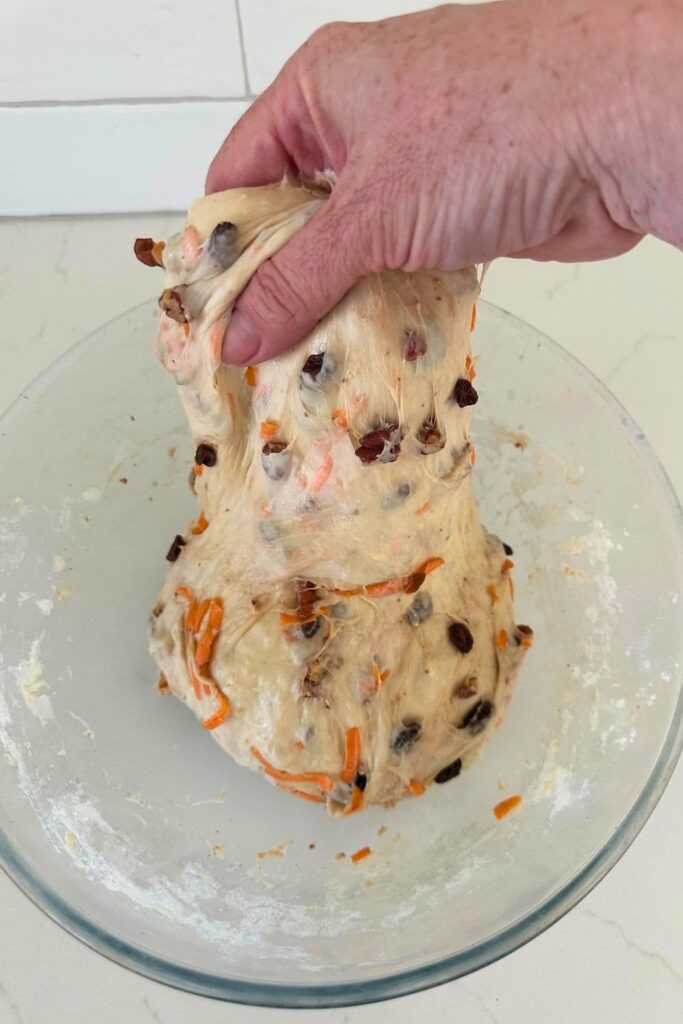
Don't worry if your dough tears a little bit, this is to be expected when adding nuts because these can tear the gluten strands. This dough is very inclusion heavy so it can be hard to stretch and fold.
Bulk Ferment
Once you've finished your stretch and folds, place the cling film or damp tea towel back over your dough and let it rest and bulk ferment at room temperature. This can happen quite quickly with the maple syrup in the dough and all the inclusions, so keep an eye on that dough.
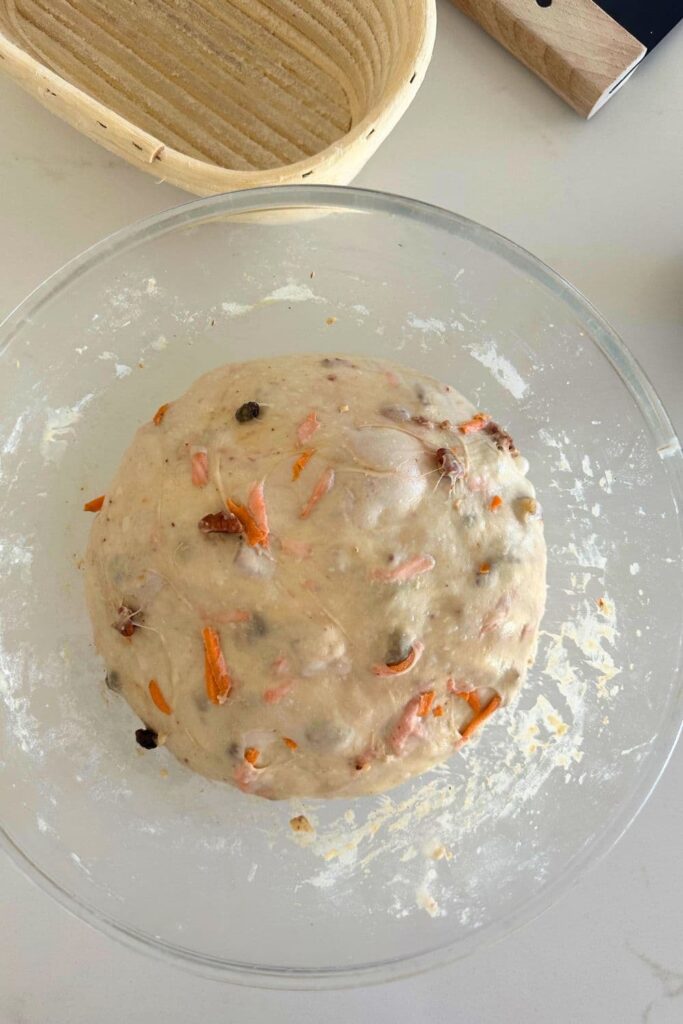
While your dough is fermenting, take a small bowl and mix the cinnamon, nutmeg, ginger, brown sugar and all purpose flour together. Set this aside until you're ready to shape your dough.
Shaping Your Dough
Once your dough has finished its first ferment, it's time to give it some shape and surface tension and add the spices that you've kept aside. I think this recipe lends itself to a batard however it's completely up to you what shape you would like.
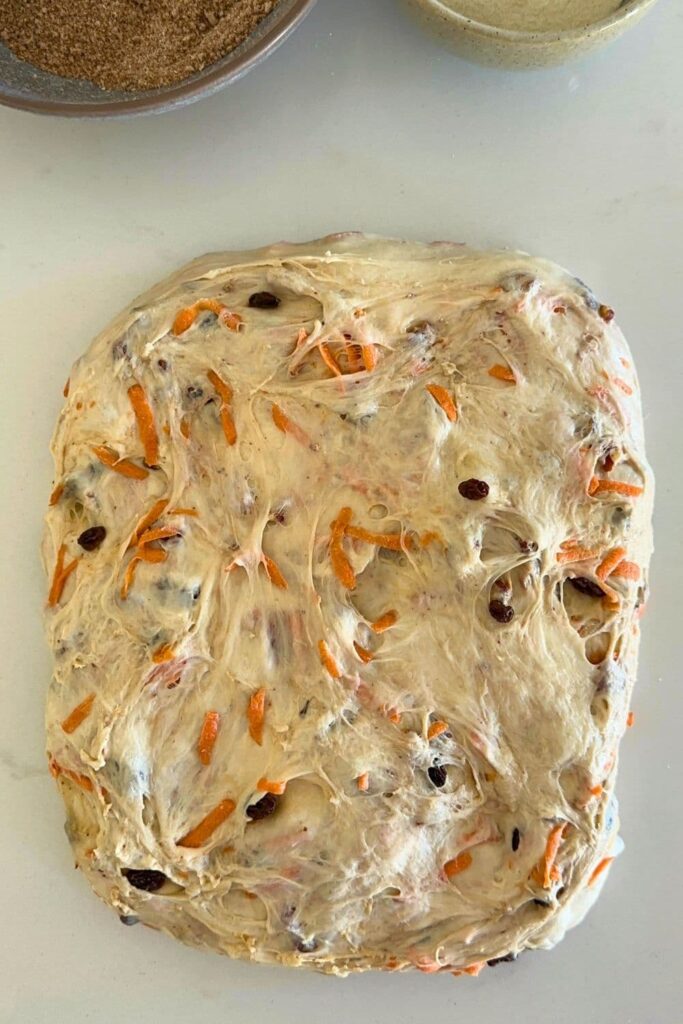
Stretch your dough out into a rough rectangle and sprinkle over a generous amount of the spice mixture. Fold the top down and sprinkle on some more. Fold the sides in, sprinkle some more. It's really up to you as to how much of the mixture you want to use.
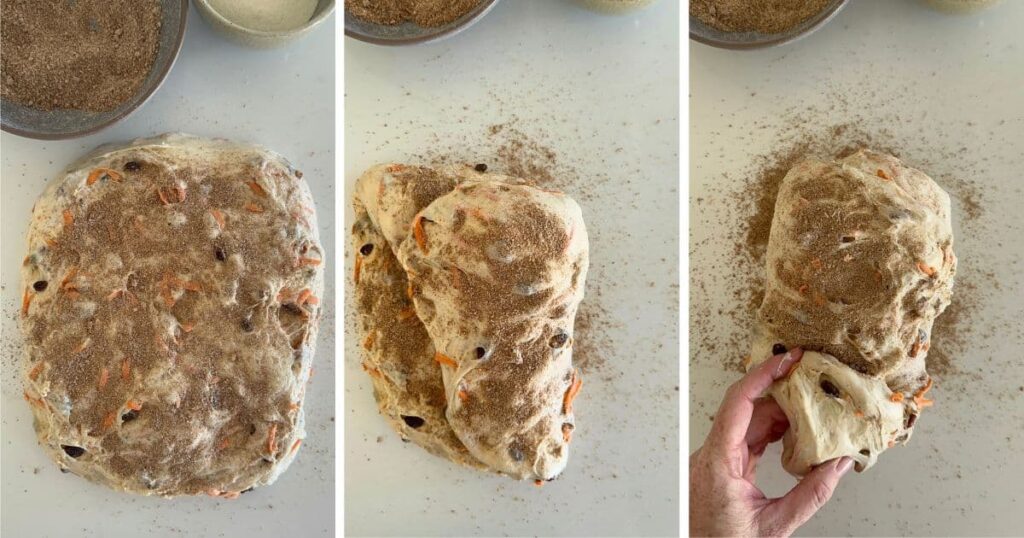
Roll up the dough like a burrito and pull it towards you to create some surface tension and ensure all of those beautiful spices are tucked up inside. Place the shaped dough into your banneton with the seam side up. Stitch the base together if you need to.
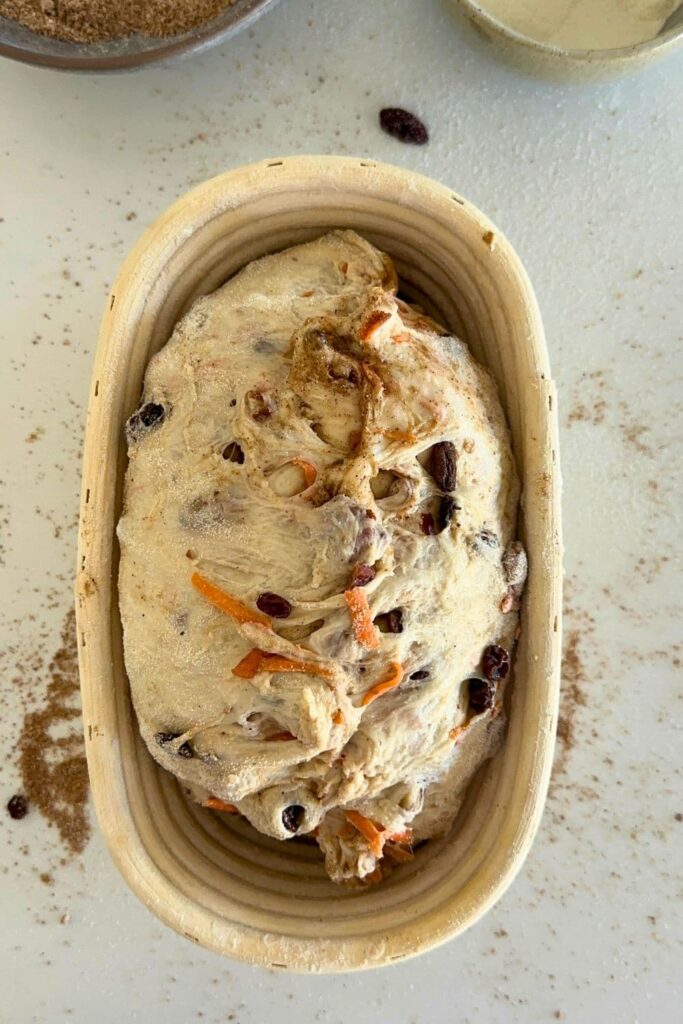
Cold Ferment
Now your dough is in it's "shaping container" cover it loosely with a plastic bag or damp tea towel and place into the fridge to cold ferment.
Try to leave it in the fridge for a minimum of 5 hours. I don't like to leave this loaf in the fridge for too long - generally I don't leave it more than 12 hours because after this the carrot can cause moisture issues.
Preparing to Bake Your Sourdough
Once you're ready to bake your sourdough, you'll need to preheat your oven to 230C/450F.Place your Dutch Oven into the oven when you turn it on so it gets hot. Try to preheat for around 1 hour to ensure your oven is super hot - but you know your oven so just adjust this time if you need to.
Baking Your Sourdough
Now it's time to bake!When your oven is at temperature. Take your sourdough out of the fridge. Gently place it onto a piece of baking paper.
Gently score your bread with a lame, clean razor blade or knife.Carefully take your dutch oven out of the oven. Place the sourdough into the pot using the baking paper as a handle. Put the lid on and place into the hot oven.
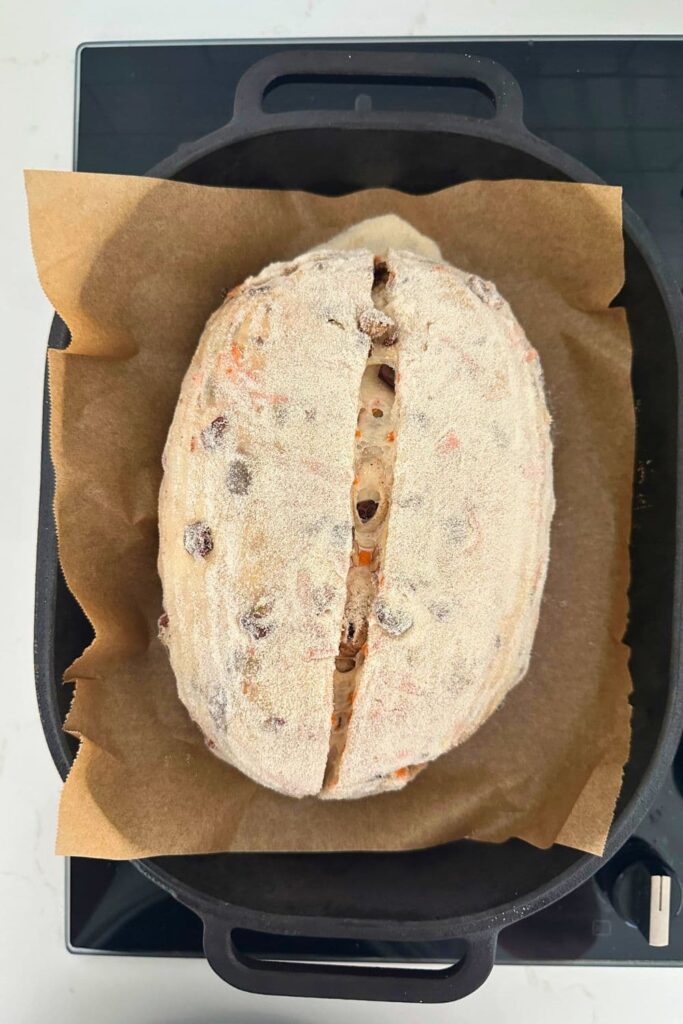
BAKE TIME:
30 Minutes with the lid on at 230C/450F
plus 10-15 Minutes with the lid off at 210C/410F
If you're worried about the base of your bread burning, place a baking sheet on shelf underneath your Dutch Oven - it works!
When you remove your dough from the oven, carefully remove it from the dutch oven as soon as possible and place on a wire rack to cool.
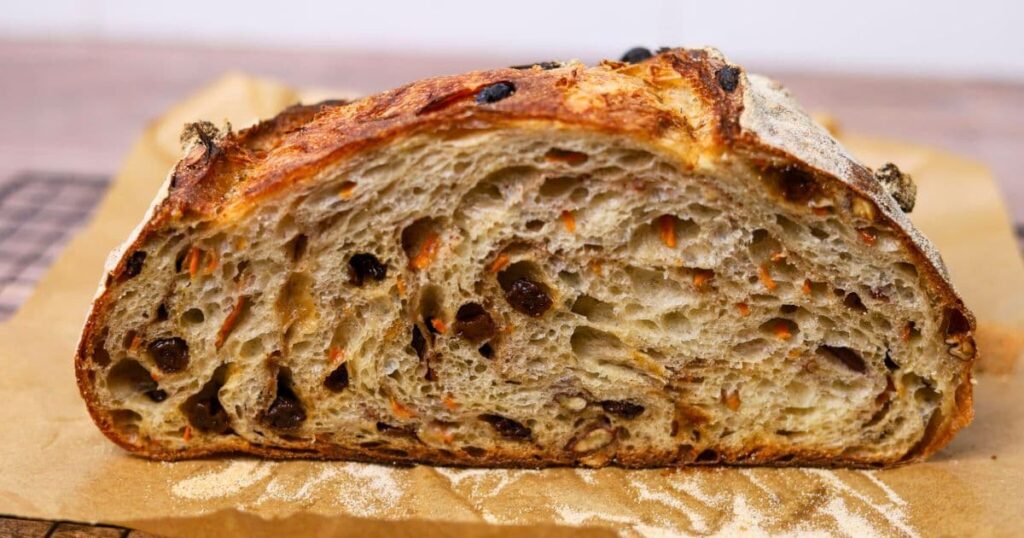
Sample Baking Timeline
| TIME | PROCESS |
|---|---|
| 9 am | Premix and autolyse for around an hour, forming up the dough and leaving to rest for another 30 minutes before stretch and folds. |
| 11 am | 1st stretch and fold |
| 11.30 am | 2nd stretch and fold - add half the carrots, raisins and pecans. |
| 12 pm | 3rd stretch and fold - add other half of the carrots, raisins and pecans. |
| 12.30 pm | 4th stretch and fold |
| 1 pm | Bulk fermentation at room temperature remembering that the maple syrup will speed up fermentation. |
| 6 pm | Shape dough into a batard, place into banneton and then into fridge for cold fermentation. |
| 9 am | Wake and bake! The next morning, you can get up, make a coffee and bake your sourdough carrot cake loaf! |
How To Serve Sourdough Carrot Cake Bread
While this is essentially a sweet sourdough loaf, it's not overly sweet so it can almost swing towards a savory loaf too. Here are some ideas of how you can serve and eat this loaf. It makes a sweet Easter gift too, paired with a flavored butter for something a little different!
- Brunch Board - use this loaf as the centrepiece to an Easter brunch, served alongside some whipped brown butter or homemade cultured butter.
- Chocolate Twist - for a dessert twist, why not lightly toast slices of this loaf to bring out the sweetness and then serve alongside your favorite chocolate spread.
- Charcuterie Board - this sourdough carrot cake loaf works perfectly alongside your favorite cheeses, as an alternative to crackers, on a charcuterie board or cheese plate. The carrots and nuts ensure it works with savory foods as well as sweet.
You might also like some of the other sourdough Easter recipe ideas here.

How to Store + Freeze
This loaf is absolute perfection to eat fresh, at least within 12 hours of baking. The crust is thin and crispy, the crumb tender and soft, but studded with crunchy pecans and swirled with sugar and spice.
I like to store the leftovers from this loaf under a glass cloche for up to 3 days. It's best to eat toasted if you're eating it past 24 hours.
You can freeze this sourdough carrot cake bread successfully by following these instructions for freezing sourdough bread.
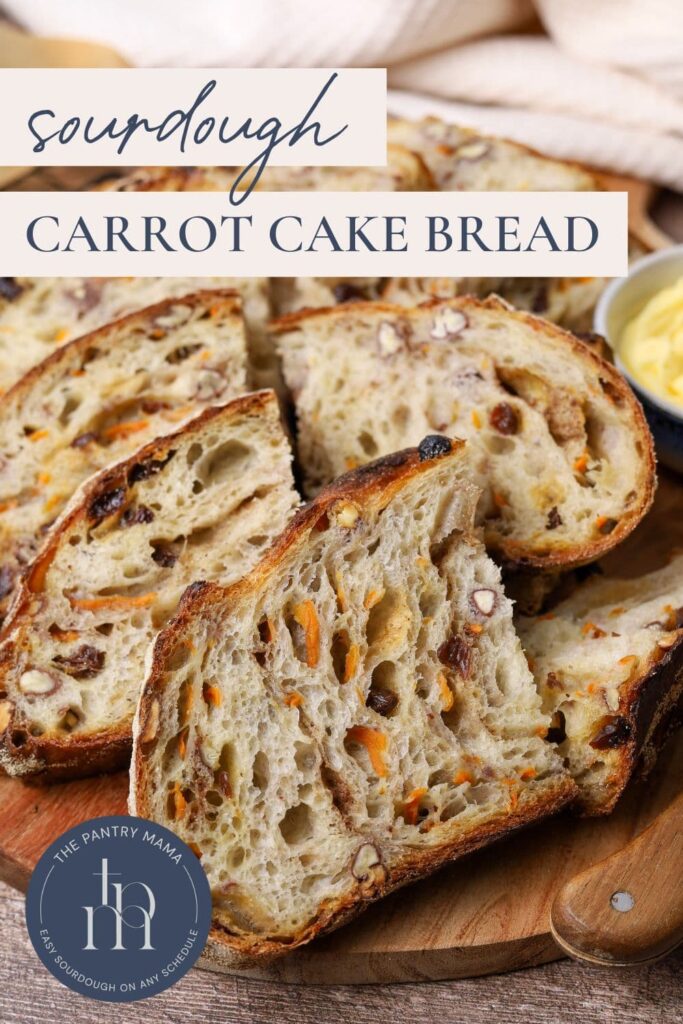

Carrot Cake Sourdough Bread
Equipment
- Mixing Bowl
- Digital Scale
- Banneton
- Dutch Oven
Ingredients
Bread Dough
- 100 g Sourdough Starter
- 350 g Water
- 40 g Maple Syrup (can use honey if you prefer)
- 500 g Bread Flour
- 10 g Salt
Added During Stretch and Folds
- 100 g Raisins (or sultanas)
- 70 g Pecans (or walnuts, chopped or can do a mix of both pecans and walnuts)
- 100 g Carrot (raw, shredded or grated)
Added During Shaping
- 1 teaspoon Cinnamon
- ½ teaspoon Nutmeg
- ½ teaspoon Ginger
- 40 g Brown Sugar
- 20 g All Purpose Flour (see notes)
Instructions
- Pre Mix & Autolyse:Weigh out your starter, water and maple syrup in a glass or ceramic bowl. Mix them together so that the maple syrup is dissolved in the water (or at least really well distributed).Then add your flour and salt and mix altogether with the end of a spatula. The dough will be fairly shaggy and only just brought together.Cover your bowl with cling film or a damp tea towel and let it sit for around 1 hour.
- Forming Up Your Dough:Work your way around the bowl, grabbing the dough from the outside, stretching it up and over itself until a smooth ball is formed. You shouldn't need more than about 20-25 folds to form the ball.Once the dough has formed into a smooth ball, pop the cling film back on and let it rest for 30 minutes.
- Stretch & Fold - Creating Structure:You need to add the raisins, chopped pecans and shredded carrot to your dough during the stretch and fold phase. It's very easy to do! Try to add them around the second or third set of stretch and folds. So do your first set of stretch and folds with the dough as is and then add the inclusions on the second (or third) set depending on how your dough is behaving. Try to do around 4 sets of stretch and folds with around 15 to 30 minutes between each set.Don't worry if your dough tears a little bit, this is to be expected when adding nuts because these can tear the gluten strands.
- Bulk Ferment:Once you've finished your stretch and folds, place the cling film or damp tea towel back over your dough and let it rest and bulk ferment at room temperature. This can happen quite quickly with the maple syrup in the dough and all the inclusions, so keep an eye on that dough.While your dough is fermenting, take a small bowl and mix the cinnamon, nutmeg, ginger, brown sugar and all purpose flour together. Set this aside until you're ready to shape your dough.
- Shaping Your Dough:Once your dough has finished its first ferment, it's time to give it some shape and surface tension and add the spices that you've kept aside.I think this recipe lends itself to a batard however it's completely up to you what shape you would like. Stretch your dough out into a rough rectangle and sprinkle over a generous amount of the spice mixture. Fold the top down and sprinkle on some more. Fold the sides in, sprinkle some more. It's really up to you as to how much of the mixture you want to use.Roll up the dough like a burrito and pull it towards you to create some surface tension and ensure all of those beautiful spices are tucked up inside.Place the shaped dough into your banneton with the seam side up. Stitch the base together if you need to.
- Cold Ferment:Now your dough is in it's "shaping container" cover it loosely with a plastic bag or damp tea towel and place into the fridge to cold ferment.Try to leave it in the fridge for a minimum of 5 hours. I don't like to leave this loaf in the fridge for too long - generally I don't leave it more than 12 hours because after this the carrot can cause moisture issues.
- Preparing to Bake Your Sourdough:Once you're ready to bake your sourdough, you'll need to preheat your oven to 230C/450F. Place your Dutch Oven into the oven when you turn it on so it gets hot. Try to preheat for around 1 hour to ensure your oven is super hot - but you know your oven so just adjust this time if you need to.
- Baking Your Sourdough:Now it's time to bake!When your oven is at temperature. Take your sourdough out of the fridge. Gently place it onto a piece of baking paper.Gently score your bread with a lame, clean razor blade or knife.Carefully take your dutch oven out of the oven. Place the sourdough into the pot using the baking paper as a handle. Put the lid on and place into the hot oven. BAKE TIME:30 Minutes with the lid on at 230C/450F plus10-15 Minutes with the lid off at 210C/410FIf you're worried about the base of your bread burning, place a baking sheet on shelf underneath your Dutch Oven - it works!
- Finishing Your Bake:When you remove your dough from the oven, carefully remove it from the dutch oven as soon as possible and place on a wire rack to cool.
Notes
- Notes on Sourdough Starter - This recipe is based on you having an active starter that you have fed a few hours before starting your bake. For information on whether your starter is ready, go here. I've used 100g of starter, but you can use less if you're baking in warmer temperatures. You can read about how to adjust the amount of starter you use here.
- Notes on Stretch & Folds - This loaf requires you to add a lot of inclusions during stretch and folds so just take it easy. The dough will tear a little but just let it rest and it will recover and absorb all of the inclusions.
- Spice Mixture & All Purpose Flour - I've added all purpose flour to the spice mixture as this can stop the brown sugar from leaking out during cold fermentation. I also recommend not letting this loaf cold fermenting for too long (I generally don't let it cold ferment for more than 12 hours).
- Notes on Baking - If you're worried about the base of your bread burning, place a baking sheet on shelf underneath your Dutch Oven - it works! If you're worried about your bread not being cooked all the way through, turn the oven off and place your dough straight onto the oven rack. Leave the door ajar and let your bread rest there for a few hours. Remember not to cut into your loaf too soon - you'll need to let it cool for at least a few hours (4-6 is best).
Nutrition

